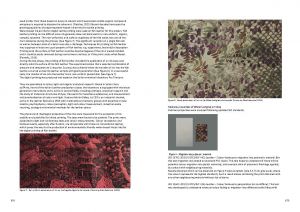Palomino, E. Defeo, G. (2019) Material Design Research - Fish skin, a new environmental -friendly material for fashion. Design Research for Change. Design Museum, London ISBN 978-1-86220-369-3
This paper explores the material design innovation process during a cross-disciplinary project
working with fish leather. The Fishskinlab project aims to generate a deeper understanding of fish
leather as an alternative to conventional leather to encourage more sustainable fashion practices.
The objective is to create aesthetically relevant fish leather products that illuminate sustainability
thinking as a driver for innovation. The project looks at the strategies implemented by practice in
the field of material design innovation fed by new technologies, addressing changes in interactions
between humans and with our environments.
The research draws on findings gathered through a partnership between the researcher, the
Icelandic tannery Atlantic Leather and the Italian analytical laboratory Ars Tinctoria connecting
fashion designers, scientists and leather technicians from the UK, Italy, and Iceland to advance
material innovation by using new technology (water-based ink digital printing methods) on fish
leather. This led to the development of a collection of digitally printed fish leather bags.
The skins were sourced at Atlantic leather, the researcher developed the prints and followed
the technical process while the digital printing was produced and tested at the Italian analytical
laboratory Ars Tinctoria.
This paper presents the journey of the mapping process, illustrating the key stages of the research,
which led to the discovery of new material properties and finishes applying digital printing processes
to a food industry by-product material such fish leather.
The methods and practices of the project included dynamic interaction between the researchers
facilitated through the cooperative framework of the project. The feedback of the work presented
during Brussels Industry days and Milano Design week offered the researcher an information flow
that influenced the development of the final prototypes and the ultimate presentation of process
and outcomes.
The findings identify that new materials, processes, and techniques are often the result of the
successful union of fashion and technology to help drive the industry towards a more sustainable
future.
https://www.designresearchforchange.co.uk/wp-content/uploads/2020/11/DR4C-FINALBOOK.pdf- Palomino, E., Pardue, J., Donkan, A. (2023) Fish skin Peoples of the Bering Strait: Encounters in Hokkaido, Japan. Smithsonian Institution National Museum of natural History. Arctic Studies Center Newsletter. May 2023. N.30. pp.74-75
- Palomino, E. (2022) Indigenous Arctic Fish Skin Heritage: Sustainability, Craft and Material Innovation. PhD Thesis. University of the Arts, London.
- Palomino, E., Cloud, J. (2022) The Arctic as viewed from Florence. Arctic Studies Center Newsletter, Smithsonian National Museum of Natural History.
- Palomino, E. (2021) Fish Skin Coat from the Amur River. TEXT for the Study of the History Art Design of Textiles. V. 48: 2021. The Textiles Society, Pat Frost (ed)
- Trachter, F., Palomino, E., Defeo, G. (2021) Patagonian fish skin tanning processes. XXXVI IULTCS Congress Greening the Leather Value Chain
- Palomino, E., Pardue, J. (2021) Alutiiq Fish Skin Traditions: Connecting Communities in the COVID-19 Era. MDPI Heritage, 4, x. Academic Editor(s): Claire Smith.
- Palomino, E., Pardue, J., (2021) A virtual Alutiiq Fish Skin workshop during Covid-19 times. Smithsonian Institution National Museum of natural History. Arctic Studies Center Newsletter. May 2021. N.30.pp-16-17
- Palomino, E., Freilich, O., Raine, I. (2021) 'A virtual Ainu fish skin workshop during Covid 19'. Global Fashion conference. Academy of Fine Arts of Warsaw. ISBN: 978-989-54263-2-4
- Palomino, E., Karadottir, K. (2021) Fish skin, a historical material assimilated as a sustainable material for fashion. In: Fashion: Culture, Craft, and Identity. Brill.
- Palomino, E., Boon, J. (2020) Preservation of Hezhen Fish Leather tradition through Fashion Education. Textiles, Identity and Innovation. Taylor & Francis.
- Palomino, E. (2020) Fashion workshop in Anchorage. Smithsonian Institution National Museum of natural History. Arctic Studies Center Newsletter. May 2020. N.27.pp. 57-58
- Palomino, E., Karadottir, K., Phirry, E. (2020) Indigenous Fish Skin Craft Revived Through Contemporary Fashion. International Foundation of Fashion Technology Institutes Journal. ISSN: 2694-5193
- Palomino, E. Defeo, G. (2019) Material Design Research - Fish skin, a new environmental -friendly material for fashion. Design Research for Change. Design Museum, London ISBN 978-1-86220-369-3
- Palomino, E. Rahme, L. Karadottir, K. (2019) Indigenous Arctic Fish skin clothing traditions: Cultural and ecological impacts on Fashion HE. CUMULUS Conference Rovaniemi. ISBN 978-952-337-158-3.
- Palomino, E. (2019) SDG 14 Life Below Water Introducing Fish Skin as a Sustainable Raw Material for Fashion. In: Franco I., Chatterji T., Derbyshire E., Tracey J. (eds) Actioning the Global Goals for Local Impact. Science for Sustainable Societies. S







